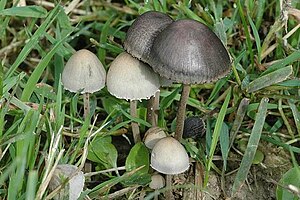Draped manure
| Draped manure | ||||||||||||
|---|---|---|---|---|---|---|---|---|---|---|---|---|

Draped manure ( Panaeolus papilionaceus ) |
||||||||||||
| Systematics | ||||||||||||
|
||||||||||||
| Scientific name | ||||||||||||
| Panaeolus papilionaceus | ||||||||||||
| ( Bull .: Fr. ) Quél. |
The toxic draped fertilizer Ling ( Panaeolus papilionaceus , syn. Panaeolus campanulatus , Panaeolus sphinctrinus ) is a species of fungus from the order of mushroom-like (Agaricales). The fruiting bodies appear on animal manure from May to October. The fungus, also called pale manure , bell-shaped manure, or wrinkled manure , may contain psilocybin .
features
Macroscopic features
The hat is 1.5–5 cm wide, conical-bell-shaped or broad-bell-shaped to domed and often has a small papilla. The matt, smooth surface is not hygrophan and is gray to gray-brown in color. When dry, the surface is silky, shiny and slightly paler. There are also forms with clearly reticulated wrinkles. The edge is slightly curved inwards, more or less notched and hung with white, jagged or fringed remains of velum when young , which can also fall off.
The bulbous, crowded lamellae are attached to the stem in an ascending manner or are almost free. They are gray-black, marbled, or piebald and often have an olive-colored tinge. The edges are whitish and the spore powder black.
The hollow, fragile stem is 6-10 (14) cm long and 0.1-0.4 cm wide. It is grayish, also reddish brown and whitish frosted at the base. In wet weather, droplets are sometimes deposited at the tip. The base is white felt. The thin, mild-tasting meat is cream-colored and smells slightly spicy, but strangely pungent at the base of the stem (typical of Panaeolus).
Microscopic features
The smooth, more or less lemon-shaped and one-sided flattened spores are 14–18 µm long, 8–12 µm wide and 8–9.5 µm thick and appear clearly oval in cross section. The germ pore emerges clearly. The cheilocystids are almost hair-shaped and hardly thickened at the base.
Species delimitation
The draped manure is relatively easy to recognize by its hat rim draped with remains of velum. If the flakes are missing, the type can be determined from the large spores. In the wide view, these have two more or less parallel outer lines, which is unique within the genre.
Ecology and diffusion
The fruiting bodies usually appear gregarious from May to October on manure and next to old dung heaps and on fertilized meadows. Often the draped manure grows directly on a cow dung. The fungus is widespread and quite common.
meaning
Like almost all fungi of the genus fertilizer, this species also contains serotonin , urea and tryptophan . It is often rumored that it also contains psilocybin and that the mushroom thus has a hallucinogenic effect, which is highly questionable. At least in European specimens, no hallucinogenic agents have so far been detected.
swell
- Paul Kirk: Panaeolus papilionaceus. In: Species Fungorum. Retrieved September 21, 2013 .
- Panaeolus papilionaceus. In: MycoBank.org. International Mycological Association, accessed September 21, 2013 .
Individual evidence
- ↑ a b c Marcel Bon : Parey's book of mushrooms . Kosmos, Stuttgart 2005, ISBN 3-440-09970-9 , pp. 264 (English: The mushrooms and tools of Britain and Northwestern Europe . Translated by Till R. Lohmeyer).
- ↑ a b c d Ewald Gerhardt: Mushrooms. Volume 1: Lamellar mushrooms, pigeons, milklings and other groups with lamellas (= spectrum of nature / BLV intensive guide ). BLV, Munich / Vienna / Zurich 1984, ISBN 3-405-12927-3 , p. 197 .
- ↑ a b c Hans E. Laux: The new cosmos mushroom atlas . 1st edition. Kosmos, Stuttgart 2002, ISBN 3-440-07229-0 , pp. 138 .
- ^ Paul Stamets, Andrew Weil (preface): Psilocybin Mushrooms of the World . An Identification Guide. Ten Speed Press, 1996, ISBN 978-0-89815-839-7 , Chapter 8, pp. 245 (256 pp.).
Web links
- Panaeolus papilionaceus. In: Funghi in Italia / funghiitaliani.it. Retrieved on September 21, 2013 (Italian, good photos from the hanging fertilizer).
- M. Kuo: Panaeolus papilionaceus. In: MushroomExpert.Com. Retrieved September 21, 2013 .